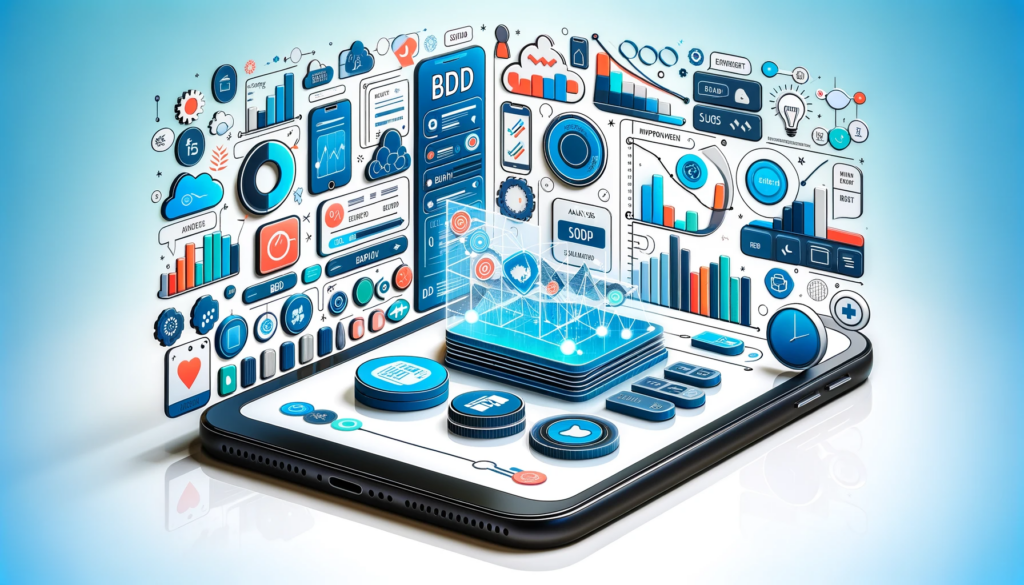Here’s a thought: ever wonder why some mobile apps feel like they’ve read your mind? Lemme tell you a secret — It’s not magic; it’s Behavior-Driven Development (BDD) at work in the Agile mobile app world. Picture this: a developer and a business stakeholder, sharing a lightbulb moment over a piece of code. That’s BDD in a nutshell – where the lines between ‘what it does’ and ‘what it means to the user’ blur, creating apps that not only function flawlessly but also resonate deeply with users.
When it comes to mobile app development services, BDD is the secret sauce that brings user stories to life, ensuring your app does exactly what your user needs, in the way they need it. So, buckle up and let’s dive into the world where code meets user psychology head-on, transforming the way we think about mobile app development.
Why does Behavior-Driven Development (BDD) matter ?
Why does Behavior-Driven Development (BDD) matter so much in mobile app development? Think about this: a whopping 21% of users drop an app after just one use if it doesn’t click with their needs. That’s where BDD makes its mark, ensuring every feature resonates with user behavior. In our smartphone-dominated world, with over 3.2 billion users, tailoring apps to user expectations isn’t just nice to have; it’s become essential.
- User-Centric: BDD aligns development with real user expectations.
- Communication Boost: Reduces project failures linked to poor communication.
- Real Impact: Shifts apps from being just functional to truly engaging.
- For Developers and Companies: Equally vital for solo developers and larger app development services.

BDD Tools and Technologies in Mobile App Development
Navigating the vast palette of BDD tools is like picking the right ingredients for a masterful dish. Each tool brings something unique to the table, enhancing the mobile app development process in its own way. Let’s explore some of the standout tools and how they fit into the world of mobile app development services.
Cucumber: Renowned for its user-friendly interface, Cucumber allows developers to write test cases in plain language. This bridges the gap between technical and non-technical team members, ensuring everyone is on the same page.
JBehave: Ideal for Java enthusiasts, JBehave supports BDD with a framework that integrates smoothly with Java applications, a common language in mobile app development.
SpecFlow: For the .NET savvy, SpecFlow is the go-to. It enables clear documentation and automates acceptance tests in a .NET environment, streamlining the workflow for many app development services.
Writing Effective BDD Scenarios for Mobile Apps
Crafting BDD scenarios is like writing a good story: it needs to be clear, engaging, and most importantly, relatable to the user. For mobile app developers, this means translating technical jargon into scenarios that anyone, from stakeholders to end-users, can understand and appreciate. Here’s how to do it right:
- Start with the User in Mind: Always ask, “What does the user want to achieve?” Your scenario should revolve around this.
- Use Simple Language: Avoid technical lingo. The goal is to make scenarios accessible to all team members, regardless of their technical background.
- Be Specific yet Concise: Details matter, but don’t get lost in them. Keep your scenarios focused and to the point.
- Iterate and Refine: Scenarios can evolve. Don’t be afraid to revise them based on feedback or new insights.
By following these principles, mobile app development services can ensure their BDD scenarios are not just technically sound but also resonate with the user’s needs and expectations. This approach leads to apps that not only work flawlessly but also deliver a user experience that keeps people coming back.
BDD and User Stories in Mobile App Development
The real magic of BDD in mobile app development lies in its synergy with user stories. It’s like taking the blueprint of what a user wants and turning it into reality, step by step. Here’s how BDD brings user stories to life in the app development process:
- Translating Needs into Features: Each user story is a promise to deliver a feature that meets a specific user need. BDD helps ensure that this promise is fulfilled accurately.
- Validating Ideas: By creating scenarios based on user stories, BDD allows developers to test and validate ideas early in the development process, ensuring alignment with user expectations.
- Facilitating Collaboration: BDD encourages ongoing dialogue between developers, designers, and stakeholders, making sure everyone understands and agrees on what’s being built.
- Streamlining Feedback: Regularly revisiting user stories during the BDD process keeps the development aligned with user needs and makes incorporating feedback easier.
Incorporating BDD with user stories not only streamlines the development process but also ensures the end product truly resonates with the users. Whether you’re part of an apps developer team in Malaysia or running a mobile app development company, integrating BDD with user stories can be your stepping stone to creating more impactful and user-centered mobile applications.

Implementing BDD in Mobile App Projects
Successfully implementing Behavior-Driven Development (BDD) in mobile app projects is about more than just following a set of steps; it’s about adopting a mindset that prioritizes clear communication and user-focused development. Here’s how to effectively integrate BDD into your mobile app development process:
- Begin with Training: Ensure your team understands BDD principles. This might involve workshops or hands-on sessions, especially for teams new to BDD.
- Define Clear User Stories: Work closely with stakeholders to develop user stories that are concise and focused on user needs.
- Develop Scenarios Collaboratively: Involve developers, testers, and business analysts in creating scenarios. This collaborative approach ensures a shared understanding of what needs to be built.
- Automate Testing: Use BDD tools to automate acceptance testing. This helps in continuously validating the functionality against user stories.
- Iterate and Refine: Use feedback from testing and stakeholder input to refine scenarios and user stories, iterating towards a product that aligns closely with user expectations.
Challenges and Solutions in BDD for Mobile Apps
Adopting Behavior-Driven Development (BDD) in mobile app projects can be transformative, but it’s not without its challenges. Let’s look at some common hurdles and how to overcome them, ensuring a smooth BDD journey.
- Challenge: Resistance to Change – Teams accustomed to traditional development methods might resist BDD.
- Solution: Gradual introduction and highlighting the benefits of BDD, such as improved communication and user-focused development, can help ease the transition.
- Challenge: Miscommunication – Misunderstandings between technical and non-technical team members can derail a project.
- Solution: Regular, clear communication and using plain language in BDD scenarios can bridge this gap.
- Challenge: Overcomplexity in Scenarios – Creating overly detailed or technical scenarios can complicate the development process.
- Solution: Focus on simplicity and relevance to the user, ensuring scenarios are easy to understand and implement.
- Challenge: Integration with Existing Processes – Incorporating BDD into existing workflows can be tricky.
- Solution: Tailor the BDD approach to fit within the current workflow, making incremental changes rather than overhauling processes overnight.
- Challenge: Keeping Up with Rapid Changes – In the fast-paced world of app development, adapting BDD scenarios to evolving requirements can be challenging.
- Solution: Embrace flexibility in the BDD process, allowing for quick adjustments to scenarios and user stories as needed.
Measuring the Impact of BDD in Mobile App Development
To truly understand the value of Behavior-Driven Development (BDD) in mobile app projects, it’s crucial to look at the metrics and KPIs that reflect its impact. Here’s how you can gauge the success of BDD in your app development endeavors:
- Enhanced Quality Assurance: Track the decrease in bugs and errors reported post-launch. A significant reduction indicates that BDD has helped in creating a more robust and user-friendly app.
- Improved User Satisfaction: Monitor user feedback and ratings on app stores. Positive trends in these areas can be a direct result of the user-centric approach BDD brings.
- Faster Time to Market: Measure the time from concept to launch. BDD’s efficiency in clarifying requirements and streamlining communication often leads to quicker development cycles.
- Increased Team Productivity: Observe the team’s output and efficiency. BDD’s collaborative nature can lead to enhanced productivity and a smoother workflow.
By closely monitoring these metrics, mobile app developers and companies can not only validate the effectiveness of BDD in their projects but also identify areas for further improvement.
Final Verdict
As we wrap up this insightful journey through Behavior-Driven Development in Agile Mobile App Projects, it’s clear that BDD is more than just a methodology – it’s a catalyst for creating apps that truly resonate with users.
At Segwitz, a leading web and mobile app development company in Malaysia, we pride ourselves on being tech strategy partners for brands of all sizes. Our commitment is to turn visionary ideas into exceptional digital experiences.
We also regularly share valuable content for brands and developers, keeping you updated on the best in tech and mobile app development on our blog. Stay tuned for more!





 Booking System
Booking System eCommerce
eCommerce On-Demand Services
On-Demand Services Community App
Community App Ordering App
Ordering App Loyalty App
Loyalty App Online Learning
Online Learning Directory
Directory Marketplace
Marketplace SaaS
SaaS P2P Platform
P2P Platform eHailing
eHailing Healthcare
Healthcare Finance
Finance Logistics
Logistics Education
Education Food & Beverage
Food & Beverage Retail
Retail FMCG
FMCG Sports
Sports Travelling
Travelling Manufacturing
Manufacturing Renewable Energy
Renewable Energy Mobile Application Development
Mobile Application Development Web Application Development
Web Application Development Source Code Review
Source Code Review Internet of Things (IoT)
Internet of Things (IoT) Cyber Security
Cyber Security SegWitz SandBox – Dev-Team as Subscription
SegWitz SandBox – Dev-Team as Subscription SegWitz Streamline – SOP Systemization
SegWitz Streamline – SOP Systemization SegWitz ScaleUp – Tech Transformation of SME & PLC
SegWitz ScaleUp – Tech Transformation of SME & PLC SegWitz StartUp – MVP & Scaling
SegWitz StartUp – MVP & Scaling